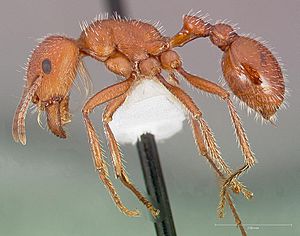Maricopa harvester ant facts for kids
Quick facts for kids Maricopa harvester ant |
|
|---|---|
 |
|
| P. maricopa worker | |
| Scientific classification |
The Pogonomyrmex maricopa, also known as the Maricopa harvester ant, is a common type of harvester ant. You can find these ants mostly in Arizona, but they also live in other U.S. states like California, Colorado, New Mexico, Nevada, Texas, and Utah. They are also found in parts of Mexico. This ant is known for having one of the strongest insect venoms in the world.
Contents
Amazing Ant Nests
Maricopa harvester ants build their homes, called nests, in the ground. Their nests often include rocks and gravel to make them sturdy.
Special Sand Caps
In areas with fine sand dunes, these ants build unique "caps" on top of their sand nests. These caps are like a protective roof. They are made from about 60% calcium carbonate, which the ants bring up from deeper soil layers.
These cemented caps help protect the nest from strong winds. They stop the sand nest from being blown away. As parts of the caps wear down, they add calcium carbonate to the sand, which can help enrich the soil.
The Maricopa Ant's Powerful Sting
The venom of the Maricopa harvester ant is very well-known for how strong it is. It's considered one of the most toxic insect venoms. For example, its venom is more than 20 times stronger than a honey bee's venom.
A sting from a Maricopa harvester ant can cause a lot of pain. This intense pain can last for up to four hours in humans.
What's Inside the Venom?
Like many insect venoms, the Maricopa harvester ant's venom is made of different chemicals. These include amino acids, peptides, and proteins. It can also contain other substances like alkaloids and organic acids.
One important part of the venom is an alkaloid poison. When an ant stings, this poison releases a special "alarm" pheromone. This chemical signal warns other ants nearby. This is an example of chemical signaling, which helps explain why many ants might sting at the same time. The venom can also have proteins that might cause a strong reaction in some people.
How They Sting
When a Maricopa harvester ant stings, it first grabs onto its victim with its strong mandibles. Then, it can pivot around that spot, stinging repeatedly. This allows the ant to inject more venom into the area.
Role in Nature
Beyond their powerful sting, Maricopa harvester ants play an important role in nature. They help with decomposition by dragging dead insects underground. This process helps to enrich the soil, which is good for plants and crops to grow.

